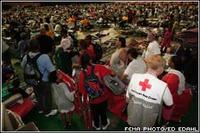Critical Commodities Continue Into Disaster Areas While Government Responds to, Challenges of Most Catastrophic Disaster in U.S. History
 | Houston, TX., September 1, 2005 - A hurricane Katrina survivor from New Orleans arriving at a Red Cross shelter in the Houston Astrodome. FEMA photo/Andrea Booher. |
Washington - FEMA, along with its federal partners, state governments and voluntary agencies, are all working to keep meals ready to eat (MREs), food, water, ice, medical supplies, generators, and other critical commodities flowing into hurricane-hit areas, said .Michael D. Brown, Department of Homeland Security’s Principal Federal Officer for Hurricane Katrina response and head of the Federal Emergency Management Agency.
“This is a disaster is of a catastrophic magnitude like none we’ve seen before,” said Brown. “It has created challenges that we are working around the clock to address and fix. In the meantime, we continue life-saving and sustaining efforts and directing resources to those with the most urgent needs.”
To date,
15,000 evacuations have been made from the New Orleans Superdome to the Astrodome in Houston and are continuing today to San Antonio for housing at Kelly Air Force Base. Evacuations will continue from Louisiana to Reunion Arena in Dallas, and Lackland AFB, Tex.
2,000 patients have been evacuated from the New Orleans airport. Seven National Disaster Medical Service Disaster Medical Assistance Teams (DMATs) and 3 strike teams are supporting New Orleans medical facilities and hospitals not fully operational and setting up MASH-style tents. Five DMATs and 5 strike teams are working in medical facilities and hospitals in Gulfport, Biloxi and other areas of Mississippi.
Commodities delivered to date include:
1.9 million MREs
6.7 million liters of water
1.7 million pounds of ice
More than 600 buses to transporting evacuees
As of yesterday, there were 204 shelters with a population of 53,004. This number fluctuates daily.
More than 170,000 meals a day are being served throughout the affected areas.
14,000 National Guard are on the ground in three states and an additional 1,400 will arrive today and 1,400 on Saturday to assist with security of victims and responders. A total of 27,000 members of the National Guard will be deployed to the affected areas.
200 Border Patrol agents, 200 additional law enforcement officers from other Louisiana jurisdictions and 2,000 officers from neighboring states are assisting in restoring order in the streets of New Orleans.
Nearly 500 U.S. Corps of Engineers civilians and soldiers are working on the New Orleans levee breach, coordinating the transport of ice
A Disaster Recovery Center (DRC) is opening today in Bayou La Batre, Ala., and another tomorrow in Chatom, Ala.
FEMA is setting up a Joint Housing Solutions Center to bring together public, private and voluntary agency stakeholders to develop innovative funding and streamlined operational partnerships to address the short and long-term housing needs of disaster victims.
More than 7,000 people have been rescued – Urban Search and Rescue task forces have made more than 2,000 rescues and U.S. Coast Guard ships, boats and aircraft have been used to rescue approximately 5,000 people.
Affected individuals in declared counties can register online for disaster assistance at www.fema.gov or call FEMA’s toll-free registration line 1-800-621-FEMA (3362) – TTY 800-462-7585, hours. Victims are encouraged to register on-line due to the possibility of high call volume. If registering by phone, owners of commercial properties and residents with only minor losses are urged to wait a few days before calling so those whose homes were destroyed or heavily damaged can be served first. Phone lines are open 24-hours, 7 days a week.
FEMA prepares the nation for all hazards and manages federal response and recovery efforts following any national incident. FEMA also initiates mitigation activities, trains first responders, works with state and local emergency managers, and manages the National Flood Insurance Program and the U.S. Fire Administration. FEMA became part of the U.S. Department of Homeland Security on March 1, 2003.
Source: FEMA more at Katrina relief or Hurricane Katrina and Katrina or FEMA and hurricane











No comments:
Post a Comment